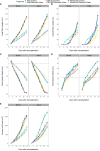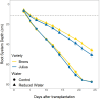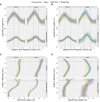Precrop-treated soil influences wheat (Triticum aestivum L.) root system architecture and its response to drought
- PMID: 38895614
- PMCID: PMC11184070
- DOI: 10.3389/fpls.2024.1389593
Precrop-treated soil influences wheat (Triticum aestivum L.) root system architecture and its response to drought
Abstract
Aims: Root system architecture (RSA) plays an important role in the plant's ability to sustain yield under abiotic stresses such as drought. Preceding crops (precrops) can affect the yield of the proceeding crop, partially by affecting the RSA. This experiment aims to explore the interactions between precrop identity, crop genotype and drought at early growth stages.
Methods: Rhizotrons, sized 60 × 80 × 3.5 cm, were used to assess the early root growth of two winter wheat (Triticum aestivum L.) genotypes, using precrop-treated soil around the seedlings and differing water regimes. The rhizotrons were automatically imaged 3 times a week to track root development.
Results: Precrop-treated soil affected the RSA and changes caused by the reduced water treatment (RWT) were different depending on the precrop. Largest of these was the 36% reduction in root depth after wheat, but 44% after OSR. This indicates that effects caused by the precrop can be simulated, at least partially, by transferring precrop-treated soils to controlled environments. The genotypes had differential RSA and reacted differently to the RWT, with Julius maintaining an 8.8-13.1% deeper root system compared to Brons in the RWT. In addition, the combined environmental treatment affected the genotypes differently.
Conclusion: Our results could help explain discrepancies found from using precrops to enhance yield as they indicate differences in the preceding crop effect when experiencing drought stress. Further, these differences are affected by genotypic interactions, which can be used to select and adapt crop genotypes for specific crop rotations, depending on the year. Additionally, we have shown a viable method of stimulating a partial precrop effect at the seedling stage in a controlled greenhouse setting using field soil around the germinated seed.
Keywords: G×E interaction; Triticum aestivum; precrop effect; rhizotron; root system architecture; water stress.
Copyright © 2024 Cope, Berckx, Galinski, Lentz, Nagel, Fiorani and Weih.
Conflict of interest statement
The authors declare that the research was conducted in the absence of any commercial or financial relationships that could be construed as a potential conflict of interest.
Figures





Similar articles
-
Clear effects on root system architecture of winter wheat cultivars (Triticum aestivum L.) from cultivation environment and practices.Sci Rep. 2024 May 15;14(1):11099. doi: 10.1038/s41598-024-61765-1. Sci Rep. 2024. PMID: 38750060 Free PMC article.
-
Precrop Functional Group Identity Affects Yield of Winter Barley but Less so High Carbon Amendments in a Mesocosm Experiment.Front Plant Sci. 2018 Jul 3;9:912. doi: 10.3389/fpls.2018.00912. eCollection 2018. Front Plant Sci. 2018. PMID: 30018627 Free PMC article.
-
Molecular and Morpho-Agronomical Characterization of Root Architecture at Seedling and Reproductive Stages for Drought Tolerance in Wheat.PLoS One. 2016 Jun 9;11(6):e0156528. doi: 10.1371/journal.pone.0156528. eCollection 2016. PLoS One. 2016. PMID: 27280445 Free PMC article.
-
ABA-Mediated Stomatal Response in Regulating Water Use during the Development of Terminal Drought in Wheat.Front Plant Sci. 2017 Jul 18;8:1251. doi: 10.3389/fpls.2017.01251. eCollection 2017. Front Plant Sci. 2017. PMID: 28769957 Free PMC article. Review.
-
Use of genotype x environment interactions to understand rooting depth and the ability of wheat to penetrate hard soils.Ann Bot. 2013 Jul;112(2):359-68. doi: 10.1093/aob/mcs251. Epub 2012 Nov 29. Ann Bot. 2013. PMID: 23204508 Free PMC article. Review.
Cited by
-
Unravelling root system architecture plasticity in response to abiotic stresses in maize.Sci Rep. 2025 Jul 1;15(1):20433. doi: 10.1038/s41598-025-04123-z. Sci Rep. 2025. PMID: 40595846 Free PMC article.
-
Rethinking Crop Rotational Benefits Under Climate Change: Beyond the Growing Season.Glob Chang Biol. 2025 Jan;31(1):e70012. doi: 10.1111/gcb.70012. Glob Chang Biol. 2025. PMID: 39739527 Free PMC article.
References
-
- AHDB (2021). “Wheat growth guide,” in Agriculture and Horticulture Development Board(Kenilworth, Warwickshire, UK: ).
-
- Angus J. F., Kirkegaard J. A., Hunt J. R., Ryan M. H., Ohlander L., Peoples M. B. (2015). Break crops and rotations for wheat. Crop Pasture Sci. 66, 523–552. doi: 10.1071/CP14252 - DOI
-
- Barraclough P. B., Kuhlmann H., Weir A. H. (1989). The effects of prolonged drought and nitrogen fertilizer on root and shoot growth and water uptake by winter wheat. J. Agron. Crop Sci. 163, 352–360. doi: 10.1111/j.1439-037X.1989.tb00778.x - DOI
LinkOut - more resources
Full Text Sources

